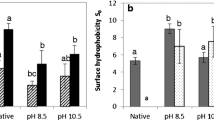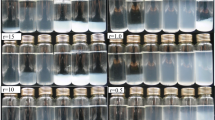Abstract
The alkali cold gelation of whey proteins is studied due to its fascinating rheological gelation profiles, as well as to investigate the existence of an alkali dissolution threshold for protein hydrogels with the protein concentration. Alkali cold gelation is achieved by first producing soluble protein aggregates followed by a sudden increase of the pH. At pH > 11.6 there is a de-gelation step with time following an initial quick gelation step. This dynamic transition involves only the formation of non-covalent interactions between the initial covalently crosslinked aggregates; first they are formed but later on they are destroyed. This mechanistic hypothesis is verified here by adding NaCl and SDS in addition to alkali. A sharp transition of the system modulus can be achieved due non-covalent interactions on soluble disulfide crosslinked aggregates in a narrow protein concentration range.










Similar content being viewed by others
References
Alting AC, Hamer RJ, de Kruif CG, Visschers RW (2000) Formation of disulfide bonds in acid-induced gels of preheated whey protein isolate. J Agric Food Chem 48(10):5001–5007
Caillard R, Remondetto GE, Subirade M (2009) Physicochemical properties and microstructure of soy protein hydrogels co-induced by Maillard type cross-linking and salts. Food Res Int 42(1):98–106
Cavallieri ALF, da Cunha RL (2008) The effects of acidification rate, pH and ageing time on the acidic cold set gelation of whey proteins. Food Hydrocoll 22(3):439–448
Chambon F, Petrovic ZS, MacKnight WJ, Henning Winter H (1986) Rheology of model polyurethanes at the gel point. Macromolecules 19(8):2146–2149
de Wit JN (2009) Thermal behaviour of bovine β-Lactoglobulin at temperatures up to 150 °C. A review. Trends Food Sci Technol 20(1):27–34
Einhorn-Stoll U, Drusch S (2015) Methods for investigation of diffusion processes and biopolymer physics in food gels. Current Opinion in Food Science. doi:10.1016/j.cofs.2015.07.002
Sadeghinezhad E, Kazi SN, Badarudin A, et al. (2013) A review of milk fouling on heat exchanger surfaces. Rev Chem Eng 29(3):169
Fish WW, Reynolds JA, Tanford C (1970) Gel chromatography of proteins in denaturing solvents: comparison between sodium dodecyl sulfate and guanidine hydrochloride as denaturants. J Biol Chem 245(19):5166–5168
Goode KR, Asteriadou K, Robbins PT, Fryer PJ (2013) Fouling and cleaning studies in the food and beverage industry classified by cleaning type. Compr Rev Food Sci Food Saf 12(2):121–143
Gordon M, Torkington JA (2009) Scrutiny of the critical exponent paradigm, as exemplified by gelation. Pure Appl Chem 53(8):–1461
Gosal WS, Ross-Murphy SB (2000) Globular protein gelation. Curr Opin Colloid Interface Sci 5(3–4):188–194
Havea P, Carr AJ, Creamer LK (2004) The roles of disulphide and non-covalent bonding in the functional properties of heat-induced whey protein gels. J Dairy Res 71(3):330–339
Khaldi M, Blanpain-Avet P, Guérin R, et al. (2015) Effect of calcium content and flow regime on whey protein fouling and cleaning in a plate heat exchanger. J Food Eng 147:68–78
Kimpel F, Schmitt JJ (2015) Review: milk proteins as nanocarrier systems for hydrophobic nutraceuticals. J Food Sci 80(11):R2361–R2366
Li H, Zhao L, Chen XD, Mercadé-Prieto R (2016) Swelling of whey and egg white protein hydrogels with stranded and particulate microstructures. Int J Biol Macromol 83:152–159
Lv H, Huang S, Mercadé-Prieto R, Wu XE, Chen XD (2015) The effect of pre-adsorption of OVA or WPC on subsequent OVA or WPC fouling on heated stainless steel surface. Colloids Surf B: Biointerfaces 129:154–160
Martin JE, Adolf D, Wilcoxon JP (1988) Viscoelasticity of near-critical gels. Phys Rev Lett 61(22):2620–2623
Mercadé-Prieto R, Chen XD (2006) Dissolution of whey protein concentrate gels in alkali. AICHE J 52(2):792–803
Mercadé-Prieto R, Gunasekaran S (2009a) Alkali cold gelation of whey proteins. Part I: Sol-gel-Sol(−gel) transitions. Langmuir 25(10):5785–5792
Mercadé-Prieto R, Gunasekaran S (2009b) Alkali cold gelation of whey proteins. Part II: protein concentration. Langmuir 25(10):5793–5801
Mercade-Prieto R, Falconer RJ, Paterson WR, Wilson DI (2006) Effect of gel structure on the dissolution of heat-induced Beta-Lactoglobulin gels in alkali. J Agric Food Chem 54(15):5437–5444
Mercadé-Prieto R, Falconer RJ, Paterson WR, Wilson DI (2007) Swelling and dissolution of Beta-Lactoglobulin gels in alkali. Biomacromolecules 8(2):469–476
Mercade-Prieto R, Paterson WR, Wilson DI (2007a) The pH threshold in the dissolution of Beta-Lactoglobulin gels and aggregates in alkali. Biomacromolecules 8(4):1162–1170
Mercade-Prieto R, Sahoo PK, Falconer RJ, Paterson WR, Wilson DI (2007b) Polyelectrolyte screening effects on the dissolution of whey protein gels at high pH conditions. Food Hydrocoll 21(8):1275–1284
Mercade-Prieto R, Paterson WR, Wilson DI (2008) Caustic-induced gelation of Beta-Lactoglobulin. Int J Food Sci Technol 43(8):1379–1386
Mercadé-Prieto R, Paterson WR, Wilson DI (2009) Effect of salts on the alkaline degradation of β-Lactoglobulin gels and aggregates: existence of a dissolution threshold. Food Hydrocoll 23(6):1587–1595
Mercadé-Prieto R, Zhao H, Zhang M, et al. (2016) Dissolution and swelling of soy protein isolate hydrogels in alkali. Food Hydrocoll 56:285–291
Nicolai T, Britten M, Schmitt C (2011) β-Lactoglobulin and WPI aggregates: formation, structure and applications. 25 Years of Advances in Food Hydrocolloid Research 25(8):1945–1962
Nishinari K, Fang Y, Guo S, Phillips GO (2014) Soy proteins: a review on composition, aggregation and emulsification. Food Hydrocoll 39:301–318
Phan-Xuan T, Durand D, Nicolai T, et al. (2014) Heat induced formation of Beta-Lactoglobulin Microgels driven by addition of calcium ions. Food Colloids 2012: Creation and Breakdown of Structure 34:227–235
Purwanti N, Smiddy M, van der Goot AJ, et al. (2011) Modulation of rheological properties by heat-induced aggregation of whey protein solution. Food Hydrocoll 25(6):1482–1489
Purwanti N, Peters JPCM, van der Goot AJ (2013) Protein micro-structuring as a tool to texturize protein foods. Food & Function 4(2):277–282
Roefs SPFM, De Kruif KG (1994) A model for the denaturation and aggregation of β-Lactoglobulin. Eur J Biochem 226(3):883–889
Ross-Murphy BS (2006) Biopolymer gelation—exponents and critical exponents. Polym Bull 58(1):119–126
Saikhwan P, Mercadé-Prieto R, Chew YMJ, et al. (2010) 2010 swelling and dissolution in cleaning of whey protein gels. Special Issue on Fouling and Cleaning in Food Processing 88(4):375–383
Schmitt C, Bovay C, Rouvet M, Shojaei-Rami S, Kolodziejczyk E (2007) Whey protein soluble aggregates from heating with NaCl: physicochemical, interfacial, and foaming properties. Langmuir 23(8):4155–4166
Sun XD, Arntfield SD (2010) Gelation properties of salt-extracted pea protein induced by heat treatment. Molecular, Functional and Processing Characteristics of Whole Pulses and Pulse Fractions and Their Emerging Food and Nutraceutical Applications 43(2):509–515
Thomas A, Sathian CT (2014) Cleaning-in-place (CIP) system in dairy plant-review. IOSR Journal of Environmental Science, Toxicology and Food Technology 8(6):41–44
Totosaus A, Montejano JG, Salazar JA, Guerrero I (2002) A review of physical and chemical protein-gel induction. International Journal of Food Science & Technology 37(6):589–601
Verheul M, Roefs SPFM, de Kruif KG (1998) Kinetics of heat-induced aggregation of β-Lactoglobulin. J Agric Food Chem 46(3):896–903
Wen Q, Basu A, Janmey PA, Yodh AG (2012) Non-affine deformations in polymer hydrogels. Soft Matter 8(31):8039–8049
Winter HH, Chambon F (1986) Analysis of linear viscoelasticity of a crosslinking polymer at the gel point. J Rheol 30(2):367–382
Yan C, Pochan DJ (2010) Rheological properties of peptide-based hydrogels for biomedical and other applications. Chem Soc Rev 39(9):3528–3540
Zhang Y-H, Tang C-H, Wen Q-B, et al. (2010) Thermal aggregation and gelation of kidney bean (Phaseolus vulgaris L.) protein isolate at pH 2.0: influence of ionic strength. Food Hydrocoll 24(4):266–274
Acknowledgments
This work was supported by the project funding from the Priority Academic Program Development (PAPD) of Jiangsu Higher Education Institutions and the “Jiangsu Specially-Appointed Professors Program” of China and the Youth Fund of Natural Science Foundation of Jiangsu Province of China (No. BK20140343).
Author information
Authors and Affiliations
Corresponding author
Electronic supplementary material
Below is the link to the electronic supplementary material.
ESM 1
(PDF 572 kb)
Rights and permissions
About this article
Cite this article
Zhao, L., Chen, X.D. & Mercadé-Prieto, R. Understanding the alkali cold gelation of whey proteins with NaCl and SDS. Rheol Acta 55, 909–920 (2016). https://doi.org/10.1007/s00397-016-0966-z
Received:
Revised:
Accepted:
Published:
Issue Date:
DOI: https://doi.org/10.1007/s00397-016-0966-z




